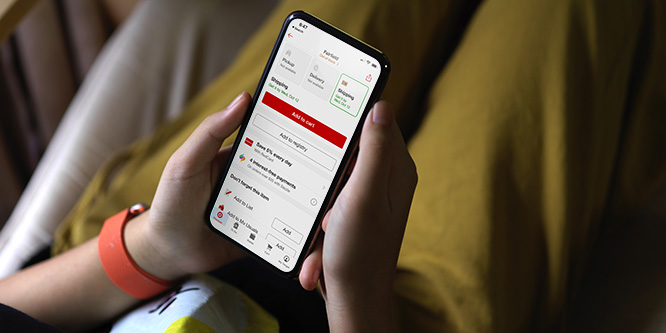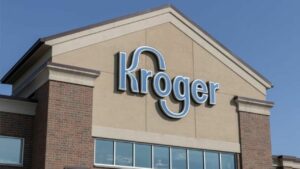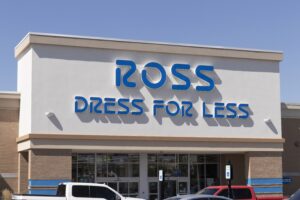
Source: Target app
October 6, 2022
What’s still lacking in retailer shopping apps?
Suzy Davidkhanian, principal analyst at Insider Intelligence, believes that, while the pandemic spurred many consumers to adopt retail app technology as in-store pickup and other omnichannel practices exploded, “many features are gimmicky or glitchy and cause more friction than convenience.”
Respondents to Insider Intelligence’s “U.S. Retail Mobile Features Benchmark 2022” survey said that the most valuable capabilities for retail apps include in-app notifications for when items are ready for pickup, scanning and saving gift cards into the user’s profile, and store stock availability. Features that enhance the in-store shopping experience — like product availability and location at a preferred store and price check — were also found to be particularly valuable.
Ms. Davidkhanian wrote in an article, “Overall, app capabilities must help consumers save time and money and make the shopping experience as frictionless as possible on the small screen.”
Lumoa’s “2022 State of Shopping Apps” study, based on an analysis of 75,000 shopping app reviews, found usability — being “user-friendly” — the single biggest reason why shoppers rate apps higher. Technical problems, such as challenges adding items to the basket or adding payment methods, were the main factor in lower ratings.
Some non-app-related variables were found to be critical to the overall success of certain categories of apps. Lumoa’s study stated, “Users of apps that sell beauty products rate positively the fact that ‘offers’, ‘coupons’ and ‘points’ are available (and easy to redeem). For grocery product buyers, it is important to have responsive ‘customer service’ and to have items ‘delivered’ timely. Apparel app users tend to provide a good rating when the vendors allow them to ‘return’ the products in an easy and convenient way.”
In a Forbes interview, Bhrugu Pange, managing director of technology services at consultancy AArete, said the best shopping apps personalize the shopper experience and merge online and offline experiences. He cited the in-store navigation capabilities within Home Depot’s app. Mr. Pange said, “This is what omnichannel must look like. Whether you are in an analog shop, on a browser or using your mobile phone. It all converges into one experience, one journey.”
- Consumers look to retailers’ mobile apps to enable seamless omnichannel experiences – Insider Intelligence
- US Retail Mobile App Features Benchmark 2022 – Insider Intelligence
- The State of the Shopping Apps Report for 2022 – Lumoa
- Mobile Commerce Is The Under-The-Radar Story In Consumers’ Flight To Digital Shopping – Forbes
- eCommerce App Marketers Spent $6.1 Billion on User Acquisition WorldWide According to New AppsFlyer Report – AppsFlyer
- S. Consumers Continue to Embrace a Mix of Online and In-Store Grocery Shopping Habits, New Acosta Report Shows – Acosta/PRNewswire
- Mobile shopping on the rise: Over 73% of US shoppers will embrace virtual cards for online purchases in the future – Klarna
Discussion Questions
DISCUSSION QUESTIONS: In what ways are retail apps providing the most value, how are they falling short, and what’s their next evolution? How do retail apps help the most with your own personal shopping journeys?
Poll
BrainTrust
Recent Discussions







Saving time and money is always desirable to shoppers. But the research on shopping behavior consistently shows that consumers want ease and convenience as their two most significant dimensions for shopping online or via an app. The UI/UX dimension of both architecture and interface for these tools has lots of room for improvement and innovative use of the technology.
Realtime inventory info is the biggest shortfall of almost every app. Over 95 percent of in-store applications are not integrated with realtime inventory — only for credit authorization. And most retailers haven’t committed to using RFID or other means to boost realtime inventory accuracy. So, these apps are almost never 100 percent accurate. We need to make the investment in a realtime infrastructure to truly get to the next level of customer service — including mobile apps.
For mobile app design, simplicity wins. Keep the screens clean and intuitive, and make swiping motions and buttons 100 percent intuitive. It’s not as easy as it sounds, but it’s what makes customers the happiest. Integration with Google Maps and Apple Maps should be seamless, too. If I’m looking for a specific retailer near me, don’t give me a short list, just start my directions to the nearest store. And if I’m already using directions, add the next one along my route and tell me how much time it will add to my trip.
Great points Ken! Inventory accuracy is key for me, especially for BOPIS orders. I recently placed a mobile order from a retailer for pick-up from a location near me and 30 minutes after my order was processed, I received an alert that the product is no longer available at the selected location. Obviously, inventory accuracy is a problem with this retailer. The obvious other mobile app imperatives are ease of use, minimal clicks and being fully featured to include the same capabilities as online sites improved with value-added features that are helpful in the store such as augmented reality and wayfinding.
Ease of use is critical to the adoption and success of any retail app, in addition to the requirement that the app must save the customer time and effort as they research, buy or return products.
Retail apps that deliver frictionless interactions, from product search to payment to fulfillment (and returns) are differentiating those retailers from their competition, no question about it. My observation is the success of the app is more about execution by the store. The easiest shopping app in the world doesn’t really help if I frequently find that my order is missing any number of items when I go pick it up. Also it’s not helpful to create a shopping list, tender payment, and then find out that I have to make a reservation to pick up my item which might be two or three days from now.
It seems that retailers keep adding bells and whistles to their apps instead of keeping to simple. Shoppers want frictionlessness, not complication. As Kathleen Fischer notes above, “the app must save the customer time and effort as they research, buy or return products.”
Any app that does not meet that function will be put aside by the shopper, and any value the app supposedly had is lost for the retailer and the customer.
Retailers have to think about how consumers are already using their phones – for messaging and for inspiration/content. Apps must include those features in order to align with the natural way consumer behaviors already lean. Then there has to be an additional benefit to using the app that a mobile site and/or an in-store experience can’t provide. If there’s no unique reason for a shopper to need an app, there’s no motivation to download and use it.
In my experience, as we evolve in this journey, retailers need to embrace the revolutionary change in technology, not just follow the tried and true, just faster, cheaper and better. I was in a national fast-food restaurant trying to use their kiosk and stood in front of this beautiful at least 24-inch portrait-oriented touch screen, with a hamburger image the size of my head, and text even I could see from over 5 feet away surrounded by fields of white space. Basically, they took their “responsive UI” and just ported it over to the larger format. Not only was it unappealing, but it also didn’t work because much of the salient information was at the bottom of the screen (think the “enter” key) that until I’ve used it a few times, will be much harder to use than just going up to the associate to place my order.
My point in this is: the technology world has changed: networks are much faster, phones, monitors and other devices are light years ahead of browser technology; and people have evolved in their use of technology. Revolutionize the experience, multi-media, UX design, AI, all the new stuff. You make it easier for me to shop. Trust me, I will.
The primary issue with most retailers is that “they created the solution but failed to concentrate on offering an ideal experience.” Several real-world examples indicate that retailers frequently disregard the user experience. Missing out on basic prerequisites lays a route to failure. As a result, many customers decide not to shop at retailers’ e-commerce stores because of their poor UI.